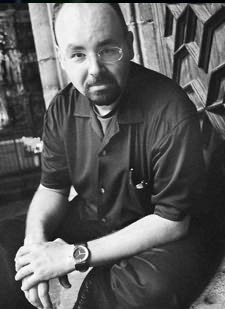Here Be Dragons…And Forgotten Books
by Adelaida Lucena de Lower
Carlos Ruiz Zafón is Spain’s most successful literary export. An urban history buff, composer, scriptwriter, dragon collector, and comic devotee, Ruiz Zafón is the author of an international, bestselling, soon-to-be tetralogy that started with the critically acclaimed The Shadow of the Wind (2001), followed by The Angel’s Game (2008) and The Prisoner of Heaven (2012). Translated into fifty languages, these novels have sold millions and managed to be popular and erudite, characteristics that suit the so-called Midas of the Spanish literary circuit.
Ruiz Zafón divides his time between his native Barcelona and Los Angeles. His outspoken preference for the cultural landscape of Berlin and California has prompted critics in Spain to charge that he has sold out. Ruiz Zafón is unapologetic: “In Spain, we live the bureaucratization of culture, and this generates mediocrity.”
His cycle, however, is set in 20th-century Barcelona, from the Twenties to the late Fifties. In his own words: “The cycle crisscross the literary universe of the Cemetery of Forgotten Books. The novels…are linked by characters and plot lines that cast thematic and narrative bridges, although each novel is a closed story, independent and contained. The series may be read in any order, or separately.” Ruiz Zafón describes the resulting structure as a Chinese box with four entry doors and four different perspectives. The reader can start wherever she wishes.
Some have argued that the series is an afterthought, the product of The Shadow of the Wind’s gargantuan success, but his method continues to appeal. Ruiz Zafón engages the reader through meta-fiction devices and allusions not only to the likes of Poe, Hugo, Borges, and Dumas, but to contemporary cinematography and graphic novels. His readers, versed in today’s multimedia narrative, appreciate novels that speak about the importance of books and have book lovers as heroes. Critics, Ruiz Zafón maintains, are the ones stuck in a 1970s bunker.
The central metaphor of these novels is a mythical cemetery of lost books, a place hidden under the tunnels of the medieval quarter of Barcelona. It stands, Ruiz Zafón says, not only for books, “but for ideas, beauty, and knowledge, for people, for the world of the mind, for memory…all the things that makes us human and provide meaning.”
If critics fault Ruiz Zafón for pulp fiction’s plot twists, they also admire his characterization. The bookseller Daniel Sempere, his friend, Fermín Romero de Torres — a thoroughly Dickensian personality — and David Martín, a writer forced into a Faustian bargain, are examples of psychologically complex characters. Even minor characters provide brilliant studies of characterization through speech.
For Ruiz Zafón, “characters must define themselves through actions and words, not through lectures and immense paragraphs. That is the foundation of the dramatic narrative.” Routinely, he lambasts the distinction between literary and genre fiction, and praises TV series as “today’s equivalent to Shakespeare’s theater.” In TV series, he argues, “You visualize a character, feel him, his words connote action…Everything stems from what he says.”
His writing method owes to film-making: “I write in the same way that movies are made, in three phases,” he says. “The first stage is pre-production: you create a map of what you will be doing. As soon as you start, you realize that you are going to change everything. Then comes filming and retrieving the film’s elements. Only the work is more complex; there are levels you had not foreseen. As you write, you also see layers and layers of depth, and you start changing things.” He points out that “The literature that has sold since the days of Cervantes and Shakespeare is the one that tells stories efficiently and professionally. I don’t believe that success is a matter of ingredients.”
As worldwide readers waiting for the cycle’s final installment can attest, Ruiz Zafón has not only the ingredients of narrative, but the alchemy necessary to magically transform them.
About the contributor: Adelaida Lucena de Lower is a writer and reviewer, working on a novel about 15th-century Spain. Contact her at www.adelaidalucenalower.com.
______________________________________________
Published in Historical Novels Review | Issue 62, November 2012







